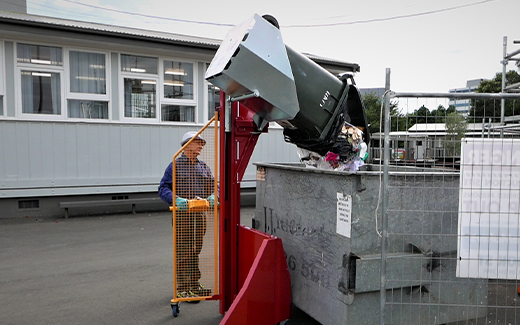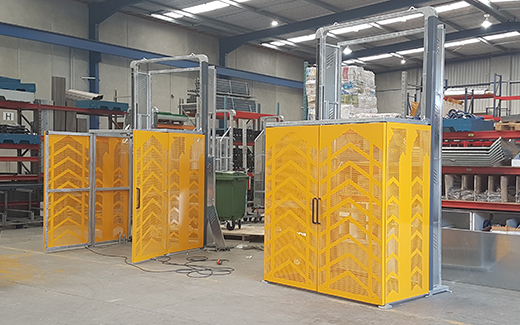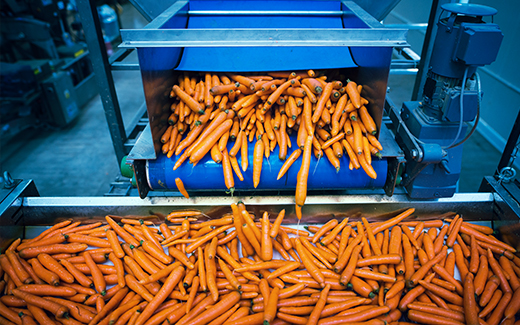In industries dealing with hazardous or high-volume waste like recycling centres, incineration plants, and food processing facilities—safety and efficiency go hand in hand. Every step in the waste handling process carries some risk, whether it’s physical strain, contamination, or exposure to hazardous materials.
That’s why bin lifters aren’t just a tool for convenience—they’re an integral part of a safer, smarter waste management process. These machines do more than lift; they reduce contact, maintain distance, and protect workers from exposure to risk at every stage of the workflow.
Let’s explore how bin lifters integrate into hazardous waste processes and how they help create safer, cleaner, and more efficient workplaces.
The reality of waste handling: Risks beyond heavy lifting
When people think of waste handling dangers, back injuries often come to mind. But in many facilities—especially those dealing with contaminated, chemical, or biological waste—the risks go much further:
- Airborne pathogens from animal waste or food by-products
- Splashback or spills from liquid or semi-solid waste
- Sharp objects or chemical exposure from mixed or industrial waste
- Heat exposure near incinerators or compactors
- Cross-contamination due to poor waste separation
In this environment, even small mistakes can have big consequences.
Manual handling isn’t just physically exhausting—it brings your staff too close to risk.
That’s where bin lifters make all the difference.
Reducing human contact at every stage
Bin lifters automate heavy and hazardous waste handling, reducing manual effort and keeping workers safely distanced. They fit seamlessly into waste workflows, ensuring clean, consistent tipping with less risk and more efficiency. Let’s look at where they fit in and how they make the process safer.
Step 1: Collection
In many facilities, waste is collected in sealed bins—either from production lines, animal waste stations, or external pickups. These bins are often wheeled to a disposal or sorting area.
Problem: Tipping these bins by hand exposes workers to the contents, risks spills, and can require close physical contact with harmful waste.
Solution: A bin lifter allows staff to securely lift and empty these bins without ever touching the contents. With enclosed tipping, there’s no need to open lids manually or shake bins by hand.
Step 2: Transfer to incinerators or compactors
At incineration facilities (like those used for animal waste or infectious material), disposal points can be hot, elevated, or difficult to access. Manual lifting is not only dangerous—it’s inefficient and exposes workers to extreme heat or fumes.
Bin lifters allow waste to be tipped directly into incinerators, hoppers, or compactors, with:
- Custom tipping heights
- Push-button control
- Safety enclosures to prevent proximity to flames or fumes
This creates a barrier between the worker and the hazardous environment.
Step 3: Ash or residue removal
Once waste is incinerated or processed, ash and residue remain. These by-products may still contain toxic substances or fine particulates that can be harmful when disturbed.
Using bin lifters to handle removal bins reduces the need for staff to bend, lift, or sift through post-processing materials, which can be dusty, hot, or contaminated.
Built-in safety features for high-risk environments
Simpro bin lifters are designed with more than convenience in mind—they’re built to be part of your site safety strategy. Let’s look at some key features:
1. Splash guards
For liquid or semi-liquid waste (like blood, oils, or industrial slurries), splash guards prevent contaminants from reaching workers or surrounding areas during tipping.
2. Safety interlocks and gates
These features stop the machine from operating unless the bin is properly positioned and guards are in place—protecting users from accidental operation.
3. Custom tipping heights
Reduce awkward movements and help position waste exactly where it needs to go—whether that’s into a raised incinerator or a sunken conveyor system.
4. Smooth, controlled motion
This prevents sudden spills or jerks that could lead to injury or exposure.
Where bin lifters fit in different industries
These are the industries in Europe where bin lifters are mostly used. Let us explore it in detail.
Pharmaceutical & lab waste
Facilities dealing with biohazards or expired medication must be extremely cautious about exposure. Bin lifters ensure sealed containers are tipped safely into approved disposal units—minimising exposure to pathogens or fumes.
Agricultural & animal processing
In places like abattoirs or farms, animal by-products and carcasses are often moved for incineration. Bin lifters let workers move this waste without direct handling, reducing infection risk and odour exposure.
Food processing & commercial kitchens
Organic waste can be messy, slippery, and dangerous to lift—especially when dealing with oils, fats, or spoiled food. A bin lifter allows hygienic disposal, even into high-sided containers.
Recycling plants
Beyond separating paper from plastic, modern recycling involves glass, batteries, metals, and e-waste—many of which pose safety risks. Using bin lifters helps maintain material stream separation and reduces injury from sharp or toxic items.
A cleaner workplace, a more reliable workforce
By reducing the need for physical interaction with waste and waste containers, bin lifters support:
- Cleaner workspaces (less spillage, fewer cleanup hours)
- Lower infection risk
- Happier, healthier workers
- Improved morale and retention
And from a business point of view, fewer injuries and better cleanliness mean:
- Lower absenteeism
- Reduced insurance premiums
- More predictable operations
Integrating bin lifters into your process
It’s not just about the machine—it’s about how it fits into your daily routine. Here’s how to do it right:
1. Map the waste flow
Identify where waste enters and exits your site. Highlight points of manual handling or close contact.
2. Match the bin types
Choose lifters that suit the bins you use (e.g., 120L, 240L, 1100L). Simpro offers fully customisable options for even unusual bin sizes.
3. Pick the right mounting
Do you need mobile lifters to move around your site? Or static models mounted to your compactor or incinerator?
4. Train for safety
Even the best equipment needs proper use. Provide quick training so staff understand how to use lifters safely and efficiently.
5. Maintain and monitor
Schedule regular maintenance and encourage staff to report any unusual movement or wear. Simpro offers full support and servicing.
Why Simpro bin lifters?
At Simpro, we understand what it’s like to run a recycling facility. We’ve worked with councils, contractors, and private companies across Europe — and we know that your equipment needs to be strong, reliable, and easy to use.
Our bin lifters are built to last and designed to fit a wide range of needs. They:
- Work with bins of all sizes, from 150 Kg to 600 Kg
- Offer smooth, hands-free lifting and tipping
- Include important safety features like push-button controls, safety gates, and adjustable heights.
- Are built to handle daily use in tough environments
- Can be customised to match your site’s layout and bin types
We have decades of experience and a deep understanding of waste handling. We will help you find the right lifting solution and support you every step of the way.
Conclusion
In waste management, the smallest changes can have the biggest impact. By reducing contact, improving control, and shielding workers from risk, bin lifters don’t just improve efficiency—they create safer workplaces.
Whether you’re dealing with contaminated waste, hot ash, or sharp debris, the right bin lifter is more than a convenience. It’s your first line of defence.
Need guidance choosing the right bin lifter? Our experts are just a call away.




